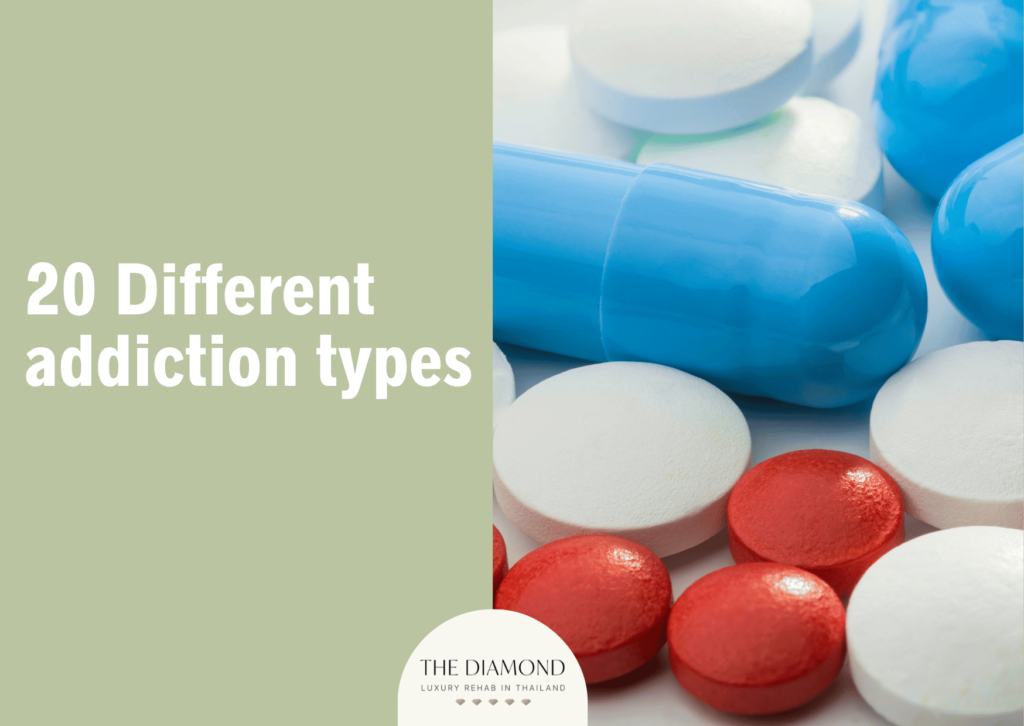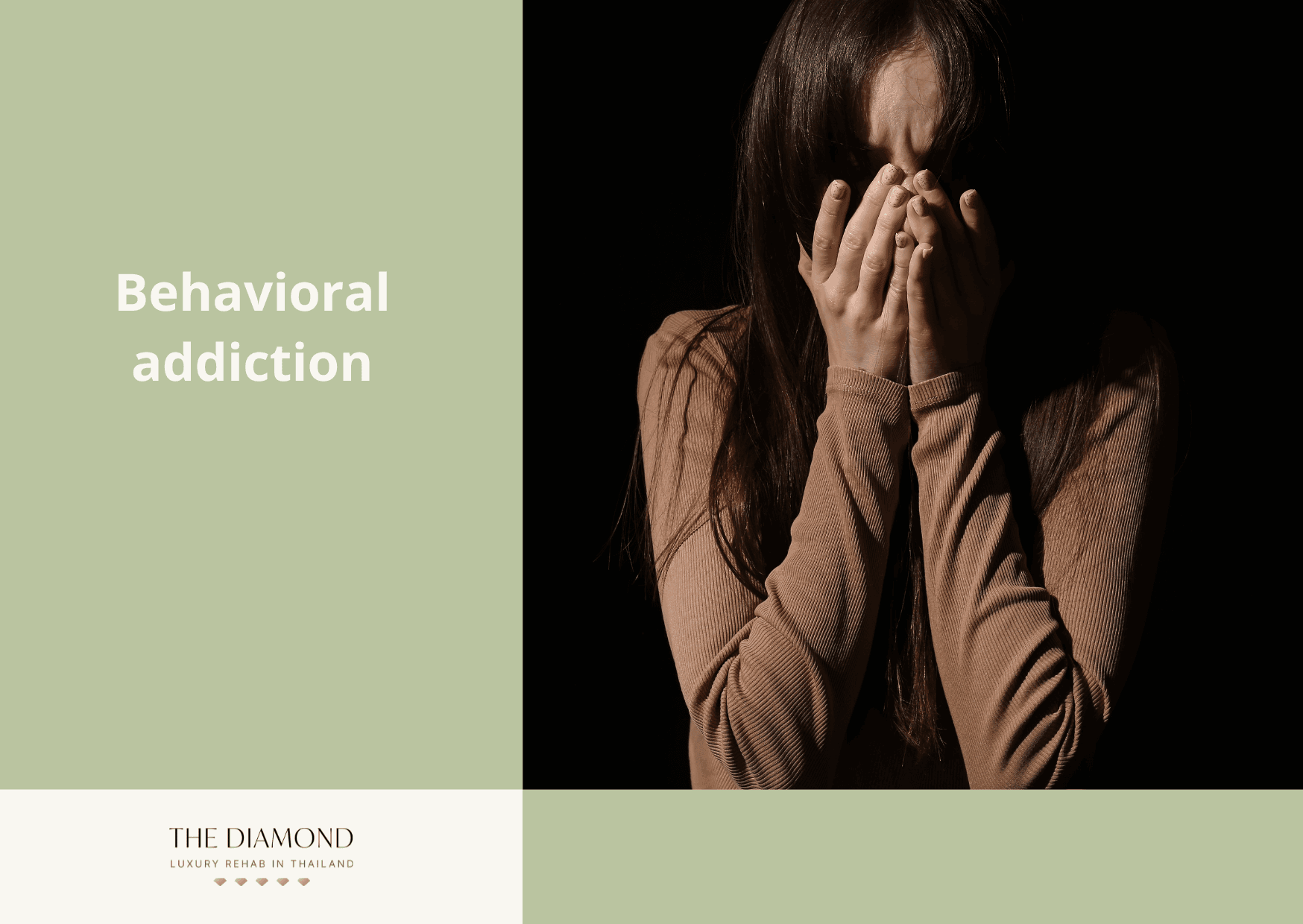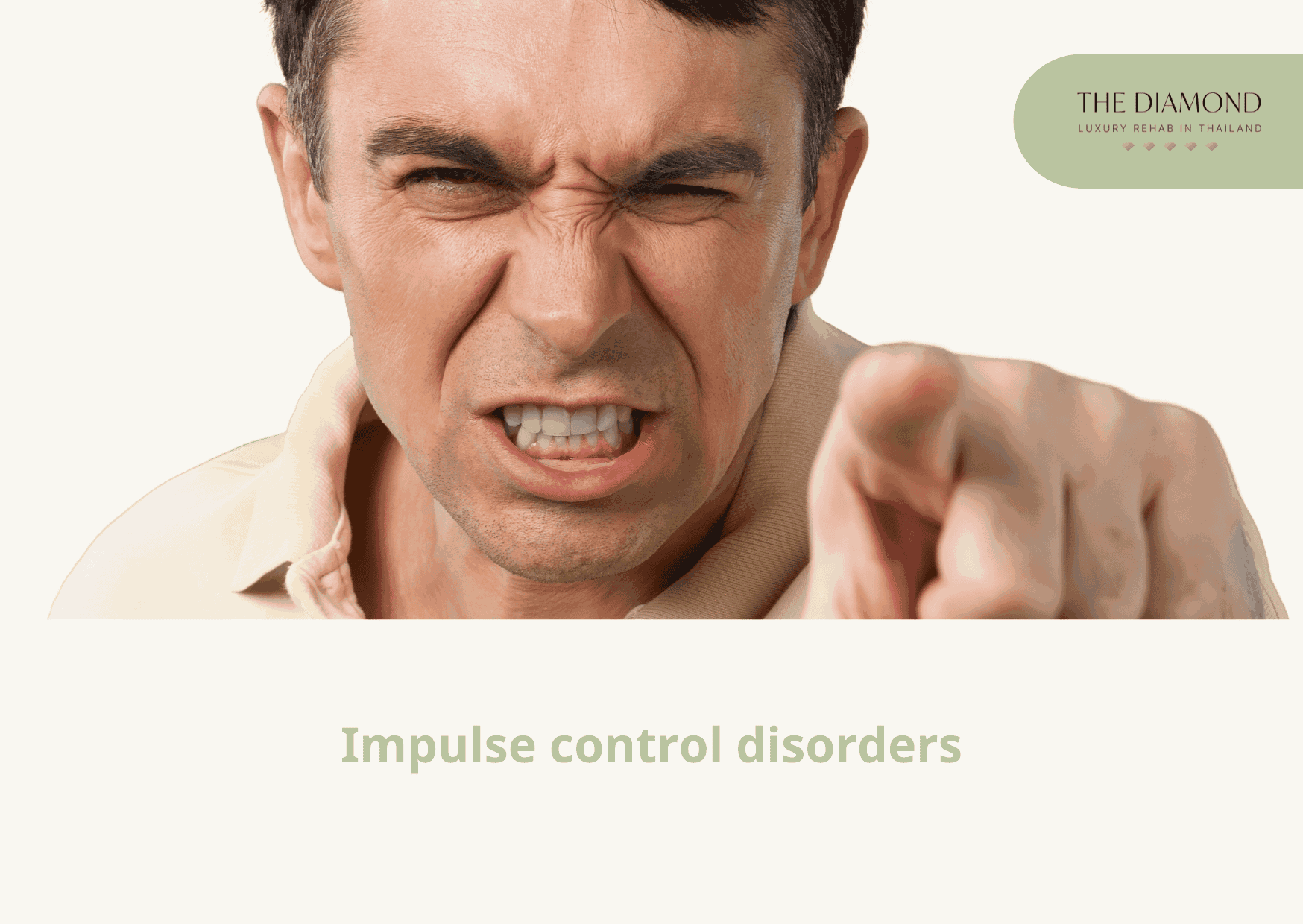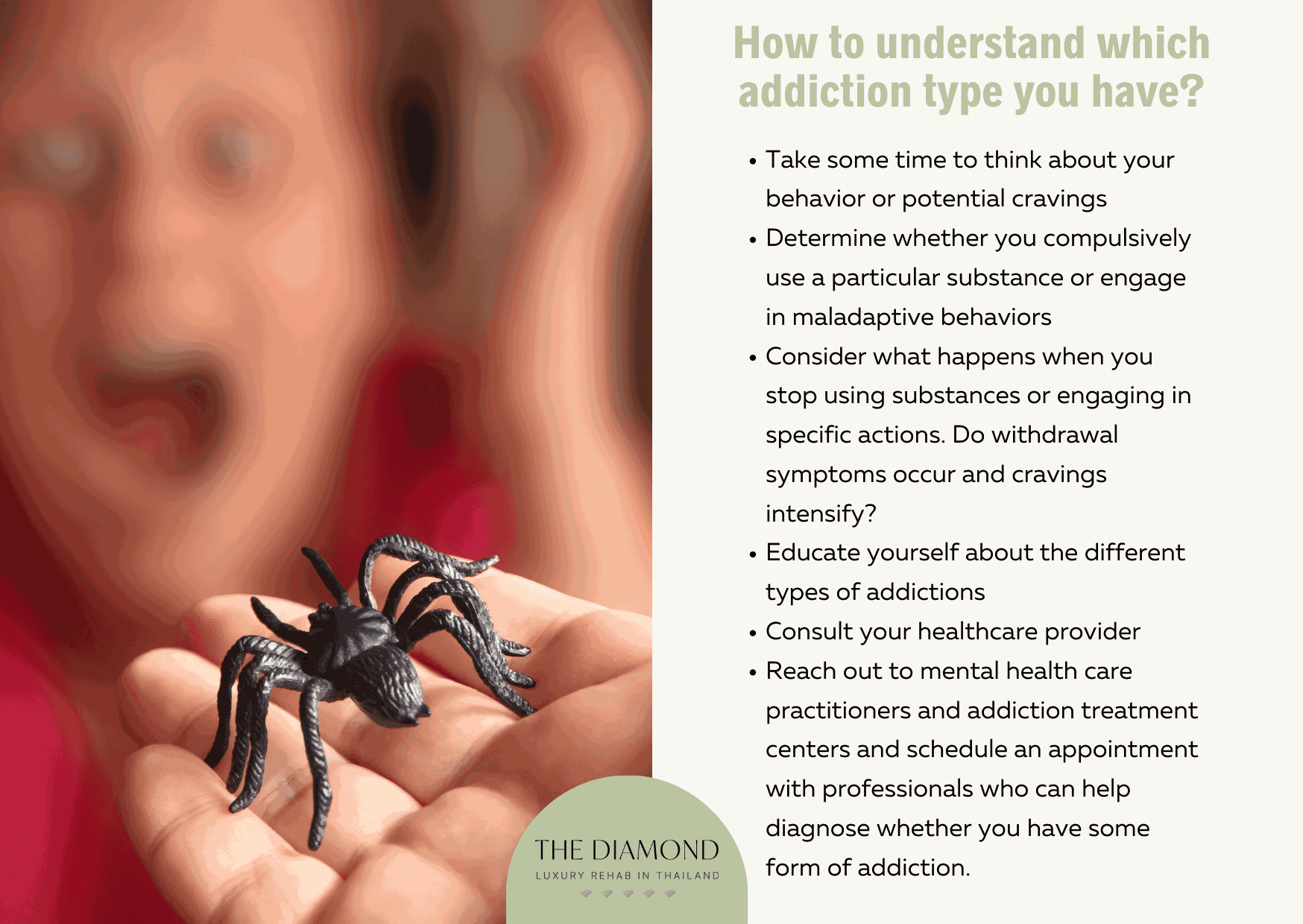20 Different addiction types: from drug addiction to porn addiction

The term addiction type refers to the different forms of addiction and addictive behaviors. The main types of addiction are listed below.
- Physical addiction is an addiction to addictive substances such as nicotine, cocaine, alcohol, and opioids.
- Behavioral addiction is a compulsive need to engage in certain behaviors such as engaging in sex, watching pornography, working, exercising, and eating.
- Impulse control disorders are characterized by the inability to control emotions and urges that may affect other people’s well-being, such as pyromania and kleptomania.
The symptoms of addiction manifests through the constant urge to repeat certain behaviors or use specific substances regardless of their associated dangers. Individuals with addiction often spend significant money and time sustaining their addiction demands. The reasons for addiction may be due to existing mental health problem and environmental and social factors. Treatment depends on the type of addiction, which commonly includes therapy and approaches involving detox and rehabilitation.
The most common addiction type is physical addiction in the form of substance use disorders, especially alcohol use disorder. According to the WHO, three million deaths occur worldwide due to the harmful consumption of alcohol.
The most dangerous type of addiction is physical addiction as it pose the most significant danger compared to other types of addiction according to the Substance Abuse and Mental Health Services Administration.
What is Physical addictions?
Physical addiction refers to disorders characterized by chronic or persistent use of tolerance-forming drugs and addictive substances. The main types of physical addiction are alcohol addiction, tobacco addiction, opioid addiction, marijuana addiction, and cocaine addiction. The main reasons of physical addiction include family history, peer pressure, existing mental health problems, neurotransmitter imbalances in the brain, and attempts to increase productivity or deal with certain emotions. The main treatment methods for physical addictions are counseling and detox.

1. Alcohol addiction
Alcohol addiction is characterized by compulsive alcohol drinking that leads to a loss of control over intake and causes various consequences to health and quality of life. It affects a person’s overall physical health. It causes liver and kidney disorders, cardiovascular and respiratory diseases, and mental health problems, as Professor Abedin Iranpour and Nouzar Nakhaee of Kerman University of Medical Sciences in Iran expanded in their 2021 review paper published in Addiction and Health. Withdrawal symptoms occur when alcohol addicts stop consuming alcohol. alcohol addiction is also indicated by symptoms of drinking secretly, inability to limit alcohol intake, losing interest in activities or hobbies, and experiencing problems in relationships or work due to alcohol intoxication. The reasons for alcohol addiction may be due to peer pressure, low self-esteem, stress, depression, media, and advertising. Inpatient and outpatient treatment programs in rehab centers are available for alcohol addiction. Alcohol addiction treatment may include individual, family, and group therapy and participation in support groups and a 12-step program.
2. Tobacco addiction
Tobacco addiction refers to the heavy dependence on tobacco products due to the addictive nature of its major component, nicotine. Nicotine is a known addictive drug because of its psychoactive effects on the brain which include pleasurable rush, bliss, reduced exhaustion, and relaxation. Dr. Donald A. Potts of UMKC School of Medicine in Kansas and Dr. John S. Daniels from St. Louis, Missouri, further adds that a person with tobacco addiction can’t stop smoking despite the problems it causes and may give up social activities in favor of tobacco use. People start using tobacco usually at a young age due to peer pressure. Reasons such as genetics, the presence of other mental illnesses, and types of drug addiction can contribute to the development of tobacco addiction. The main courses of treatment for tobacco addiction are counseling and nicotine replacement therapy. Treatment centers are available for this form of addiction.
3. Opioids
Opioid addiction is characterized by the compulsive drug-seeking and use of opioids, prescription pain medication, and illicit drugs such as heroin despite its negative consequences and withdrawal effects after cessation. In a 2019 review paper published in the International Journal of Molecular Sciences, researchers from the USA and Taiwan explained the impact of opioid abuse on the behavior of people with opioid addiction. Opioids affect an individual by impairing their cognitive and behavioral functioning that persists beyond the cessation of opioid intake. Furthermore, long-term addiction damages the brain’s intellectual function, resulting in poor judgment that manifests in difficulty maintaining healthy relationships and stable jobs. Reasons for opioid addiction include environmental, genetic, and lifestyle factors. Treatment of opioids can take place in inpatient rehab centers. Outpatient treatment and support groups are also available. Detox is often the first step, and a person may receive medications to manage withdrawal symptoms. Psychotherapy is also provided.
4. Marijuana addiction
Marijuana addiction is a disorder associated with chronic relapse caused by compulsive marijuana use and intake despite its detrimental effects and withdrawal symptoms when deprived of the drug. A 2018 paper by researcher Amna Zehra and colleagues from National Institute on Alcohol Abuse and Alcoholism in Maryland further explains the effects of marijuana addiction in their review published in the Journal of Neuroimmune Pharmacology. Prolonged marijuana abuse influences a person’s physical and mental health. It significantly affects motivation, such as decreased motivation and capability to manage daily activities and increased fatigue and aggression. Not every person who uses marijuana will be addicted. The reason for the addiction can be attritubed to risk factors that include genetics, family history, socioeconomic status, and environmental influences. Treatment programs can be in the form of inpatient and outpatient programs. Treatment of marijuana addiction involves therapy programs that target withdrawal symptoms combined with pharmacological treatments focused on reducing marijuana use and preventing relapse.
5. Prescription drug addiction
Prescription drug addiction is a type of physical addiction that involves compulsive use and misuse of prescription medication, usually medications for pain management and treatment of mental health problems, beyond prescribed doses. According to a research report published by the National Institute on Drug Abuse, overconsumption of prescription drugs may pose health risks in respiratory function, cardiovascular failure when taken in higher doses, dependence and tolerance, and withdrawal complications upon discontinued ingestion. For example, withdrawal symptoms may include fatigue, depression, and disturbed sleep patterns. The most common types of prescription drug abuse involve opioids, benzodiazepines and barbiturates, and stimulants. Reasons behind this addiction are to experience the “high” effect, relax, alleviate tension, or peer influence and pressure, while some take them to be more productive. Treatment options involve behavioral treatment, such as CBT and medications. Treatment centers or rehabs are available for this type of addiction. Treatment includes detox and counseling.
6. Inhalants addiction
Inhalant addiction is the intentional inhalation of vapors by sniffing from chemical products to become intoxicated or achieve a “high” effect. The 2021 case report published in Emerging Trends in Drugs, Addictions, and Health by a team of researchers from Italy and the UK reports that the most widely used inhalants are nail polish remover, paint thinner, glue, hair spray, gasoline, and nitrites. These inhalants might contain harmful chemicals that, when consumed frequently and in more significant amounts, cause harmful health outcomes like central nervous system depression, cardiac arrhythmias, hypoxia, metabolic acidosis, and lasting neuro-cognitive impairment. The common risk factors for inhalants addiction include family history of substance abuse, personal history of mental illness or substance abuse, and social and environmental factors. Types of treatment for this kind of addiction include medical detoxification, inpatient rehabilitation, and outpatient programs.
7. PCP addiction
PCP addiction is an addiction to a mind-altering hallucinogen called phencyclidine. In a clinical review published in the California Journal of Emergency Medicine, Dr. Tareg Bey and Dr. Anar Patel from the University of California discussed the components behind PCP addiction. PCP is formerly used as an anesthetic and animal tranquilizer. It can cause hallucinations, fake highs, and delusions when heavily consumed. PCP addiction can jeopardize mental and physical health and manifest as anxiety, paranoia, aggression, memory loss, depression, respiratory problems, and seizures. Reasons for PCP addiction may potentially be due to environmental influences, life stressors, imbalances in brain chemicals, and peer pressure. An individual with PCP addiction can receive treatment in inpatient and outpatient programs, depending on the severity of the addiction. PCP addiction treatment revolves around individual or group counseling sessions.
8. Amphetamine addiction
Amphetamine addiction is a condition associated with the compulsive use of a highly addictive stimulant, amphetamine, and the presence of withdrawal symptoms upon cessation. This type of addiction develops due to chronic amphetamine use that leads to tolerance, consuming higher doses to achieve the same effects, and dependence, suffering from withdrawal symptoms when stopping or reducing consumption. Amphetamine use can induce euphoria, heighten alertness, and boost energy and confidence. According to a 2019 systematic review paper published in eClinicalMedicine by researchers led by Professor Rebecca McKetin of the University of New South Wales in Sydney, amphetamine addiction causes harmful effects in the body and the brain, namely increased level of psychosis, depression, suicidality, and heightened level of interpersonal violence. One of the reasons behind amphetamine addiction is the misuse of prescriptions. It may also stem from underlying mental health problems and existing substance use disorders. Inpatient and outpatient programs in treatment centers are available for amphetamine addiction, while behavioral therapy is an option. Medical detoxification may also be necessary under medical supervision.
9. Cocaine type of addiction
Cocaine Type of Addiction is the obsessive use of cocaine despite its medical, psychological, and behavioral repercussions. A 2022 review paper published in Substance Abuse and Rehabilitation led by research physician Elizabeth Schwartz of Yale University assessed the current perspectives on cocaine addiction. A psychostimulant like cocaine stimulates the sympathetic nervous system and produces effects of enhanced arousal, vigor, activity, alertness, and positive mood, along with loss of appetite and sleep. Prolonged cocaine intake can cause acute kidney and liver problems, worsen cardiovascular and respiratory diseases, and induce psychiatric comorbidities such as mood disorders, anxiety, and suicidal ideation. Social pressure, existing mental health problems, and genetics are the potential reasons people use cocaine and develop an addiction. A shared environment highly influences cocaine addiction and increases the risk of substance abuse disorder. Treatment of cocaine addiction is possible through pharmacological and behavioral treatments. Inpatient and outpatient treatment centers and programs are also available. The most common approach is through behavioral therapies and counseling.
10. Hallucinogens type of addiction
Hallucinogens addiction is a type of substance addiction that revolves around the compulsive use of hallucinogens, drugs that alter an individual’s awareness of their surroundings, thoughts, and feelings. Hallucinogens like LSD, psilocybin, mescaline, and DTM are psychedelic drugs used for their therapeutic properties in mental health disorders. In a 2022 paper published in the Journal of Psychopharmacology, researchers from the UK and USA led by Anne Schlag from King’s College London expounded on the effects of excessive hallucinogen use. They cause illicit shifts in sensory awareness, cognition in the form of self-consciousness and mystical experiences, and improved moods and euphoria. Continued use of hallucinogens may increase psychedelic tendencies that may develop into harmful behaviors leading to suicidal attempts and prolonged psychosis. People often try hallucinogens out of curiosity, while others do due to mental health problems and existing substance addiction. Behavioral therapies are, so far, considered the most helpful approach. Persons with Hallucinogens Type of Addiction can receive help in rehab centers and inpatient or outpatient programs.
11. Methamphetamine addiction
Methamphetamine addiction is a type of addiction where a person becomes heavily dependent on a potent stimulant drug called methamphetamine, or meth for short, through smoking, snorting, swallowing a pill, or injecting the powder dissolved in alcohol or water. Addiction to this highly potent drug can cause increased wakefulness, faster breathing, decreased appetite, high blood pressure, extreme weight loss, severe dental problems, memory loss, excitement, and motor hyperactivity. Cardiovascular and cerebrovascular diseases are among the medical problems associated with long-term methamphetamine addiction, as Dr. Martin P. Paulus and Dr. Jennifer L. Stewart of the University of Tulsa presented in their 2020 paper published in JAMA Psychiatry. The causes of methamphetamine addiction may be genetic, environmental, physical, and psychiatric factors. A person may consume meth for recreational or self-medication purposes to deal with psychological comorbidities, and may be due to social and environmental influences. Treatment of methamphetamine addiction is administered in a wide range of rehab centers. The most effective treatments are behavioral therapies like CBT and motivational incentives.
What is Behavioral addiction?
Behavioral addictions are non-substance addictions characterized by a compulsive need to engage in maladaptive behaviors. The main types of behavioral addiction are sex addiction, food addiction, porn addiction, work addiction, and exercise addiction. Behavioral addiction may physically, mentally, and socially affect an individual. These addictions are often caused by underlying mental health disorders, life stresses, and changes in the brain. According to a 2018 paper from the Annual Review of Clinical Psychology by Dr. Nancy M. Petry, Dr. Kristyn Zajac, and Dr. Meredith K. Ginley of the University of Connecticut School of Medicine, persons with behavioral addictions may have one or two concurrent types of addictions. The primary treatment method is psychotherapy. Behavioral addiction disorders can be treated in treatment centers or rehabs.

1. Sex addiction
Sex addiction is characterized by an uncontrollable and compulsive desire for sexual thoughts, urges, and impulses to achieve a “fix” that a person with substance abuse gets from consuming a particular drug or alcohol. A 2015 review paper by Neuropsychologist Katherine L. Derbyshire and Professor Jon E. Grant of the University of Chicago published in the Journal of Behavioral Addictions explores the components of sex addiction, including its problematic clinical elements that are associated with obsessive sexual thoughts and fantasies, lying to cover behaviors, preoccupation with having sex, feeling guilt or remorse after sex, and engaging in risky sexual behaviors. Developing this type of addiction may be due to existing substance use disorders, childhood trauma, and comorbid psychiatric and psychological conditions. Sex addiction may be treated in treatment centers and rehabs. The most common approach is Cognitive Behavioral Therapy. Support groups are also available.
2. Food addiction
Food addiction is a behavioral addiction wherein a person becomes dependent on certain types of food and has intense cravings and difficult-to-control urges to eat food. A person with food addiction has a severe and frequent need to eat certain foods despite feeling full. According to a 2022 review paper published in Frontiers in Psychology by Dr. Octavian Vasiliu of Dr. Carol Davila University Emergency Central Military Hospital in Romania, food addiction can lead to harmful consequences such as a higher risk of physical health complications of obesity, diabetes, heart disease, and depression. It can also affect an individual’s quality of life, relationships, and self-esteem. Emotional problems, severe depression, stress, genetics, trauma, and brain chemistry all play a role in the development of food addiction. Treatment for food addiction requires counseling and therapy, including one of the most common types of addiction therapy – CBT. Various treatment centers provide help to persons with food addiction.
3. Pornography addiction
Pornography addiction is a compulsive behavior that involves excessive viewing of pornography to the point that it affects a person’s quality of life. According to a 2021 study published in Frontiers in Psychology, Christina Camilleri and her team from the Franciscan University of Steubenville in Ohio emphasized the implications of porn addiction and that it can be physical, psychological, and social problems such as sexual dysfunction, feeling ashamed, and embarrassed, and emotional detachment. Reasons for porn addiction include underlying mental health conditions, relationship issues, unhealthy cultural norms, and biological factors. Treatment may consist of psychotherapy, counseling, and lifestyle changes. Treatment centers and rehabs may also offer services and help to persons with porn addiction.
4. Exercising addiction
Exercise addiction is a behavioral addiction indicated by compulsive engagement in any type of physical exercise despite harmful consequences. It can affect a person both physically and mentally. Overexercising can cause physical injuries, psychological distress that can interfere with self-worth and image, and eating disorders. In a 2023 overview paper by researchers Aviv Weinstein from the University of Ariel in Israel and Attila Szabo of ELTE Eötvös Loránd University in Hungary published in Dialogues in Clinical Neuroscience, people may develop exercise addiction due to constant pressure to stay in shape, comorbid mental health disorders like anxiety, depression, and abnormal eating habits, and narcissism and perfectionism. One of the most common treatment options for exercise addiction is CBT. Various inpatient and outpatient programs are available for persons with exercise addiction.
5. Working addiction
Work addiction is the uncontrollable urge to overwork and difficulty detaching from work. A 2020 paper published in the International Journal of Environmental Research and Public Health by a group of professors led by Professor Frédéric Dutheil of the University Hospital of Clermont-Ferrand in France discussed that overworking could cause harmful physical and mental health problems, including losing sleep due to work, being obsessed with work success, fear of failure at work, and using work to avoid relationships and other aspects of life. The reasons behind work addiction can be psychological, social, and environmental factors. Treatment options for work addiction may include therapy, support groups, and behavioral approach. Some inpatient and outpatient rehabs help persons with working addiction manage their problems through therapy. Support groups are also available.
6. Spiritual obsession type of addiction
Spiritual obsession addiction, or religious addiction, is distinguished by compulsive engagement in religious and spiritual practices while neglecting other aspects of life. A person with this disorder may feel guilt or shame when not engaging in religious activities. What causes spiritual obsession addiction is unknown, but it could be a combination of environmental factors and mental health problems. The best approach to this and other types of behavioral addiction is through therapy. Currently, no specific rehab centers focus on the treatment of this addiction.
7. Cutting addiction
Cutting addiction is a disorder that exhibits an intentional self-harm behavior to deal with distress and other emotions. In a 2021 narrative review published in Issues in Mental Health Nursing, Professor Britt-Marie Lindgren and her colleagues from Umeå University in Sweden explored the origins and consequences of cutting addiction. This addiction can harm a person’s physical health by exposing them to medical complications such as wound infection from the cuts, nerve damage, and blood loss. It can also harm mental health by causing emotional distress, guilt, shame, and dependency. Reasons behind cutting addiction may include coping with unbearable and overwhelming emotions, getting immediate relief from emotional pain, or as a form of self-punishment. Self-harm is also associated with coexisting mental health disorders such as depression, anxiety, drug addiction, and eating disorders. Various rehab and treatment centers are available to help persons with cutting addiction through therapy sessions.
8. Shopping addiction
Shopping addiction is an inability to control the urge to make purchases constantly. People with shopping addiction may shop to cope with stress and anxiety, relieve boredom, and indulge in the excitement incited by purchase. Shopping addiction can cause severe problems with finances and compulsive collecting. This addiction stems from deeper emotional issues, mental health conditions, and external environmental influences. Treatment requires therapy, but 12-step programs and support groups are also available for shopping addiction.
9. Playing video games type of addiction
Video game addiction or gaming disorder is indicated by persistent and dysfunctional engagement in video games, even if it causes physical and mental distress. According to a 2022 systematic review by Professor Veronica Rosendo-Rios of Colegio Universitario de Estudios Financieros and professors from India and the UK published in Addictive Behaviors, gaming addiction significantly impacts an individual’s personal, family, social, educational, and occupational relationships. These are the result of impaired gaming control due to persistent gaming. Video games are designed to be addictive, but overexposure can influence dopamine levels and make a person keep playing to experience the pleasurable effects. The most common treatment method for playing video games type of addiction is Cognitive Behavioral Therapy. It can be treated in inpatient and outpatient treatment centers that provide services to persons with video game addiction.
What are the Impulse control disorders?
Impulse control disorders are conditions characterized by impulses and behaviors that endanger oneself or others and cause social impairment. The American Psychiatric Association describes the characteristics of impulse control disorders as struggling to resist urges or impulses to indulge in excessive and harmful behaviors. The main types of impulse control disorders are intermittent explosive disorder, kleptomania, gambling, and pyromania. A clinical review by Liana Schreiber and colleagues from the University of Minnesota Medical Center, published in Frontiers in Impulsivity, Compulsivity and Behavioral Dyscontrol, suggests that genetics, social, environmental, and biological factors may contribute to the development of impulse control disorders, but their exact causes remain unknown. The primary treatment approach for impulse control disorders is therapy, usually CBT.

1. Intermittent Explosive Disorder
Intermittent explosive disorder is a mental disorder indicated by sudden, repeated aggressive, violent, and impulsive episodes. A person may resort to physical abuse and verbal aggression and react in a way that isn’t proportional to the situation. People with intermittent explosive disorder may display rage, irritability, higher energy, tremors, palpitations, and racing thoughts. These outbursts can affect a person’s life, leading to complications in relationships, work, school, and legal issues. According to a clinical review published in Frontiers in Impulsivity, Compulsivity and Behavioral Dyscontrol by Liana Schreiber and colleagues from the University of Minnesota Medical Center, people with intermittent explosive disorders may suffer from comorbid psychiatric conditions like mood and anxiety disorders and substance abuse. A history of physical abuse, biological, and genetics are risk factors for this disorder. Treatment of intermittent explosive disorder includes psychotherapy, while some patients may get antidepressants. Behavioral health hospitals can aid treatment of this disorder.
2. Kleptomania
Kleptomania is a recurrent, irresistible urge to steal, not for financial gain or personal use. Individuals with kleptomania experience an uncontrollable desire to steal things they don’t need or want. This is accompanied by increased tension, anxiety, and excitement that stealing satisfies—however, the repercussions of stealing often cause guilt, shame, and depression. In a review and case report by Dr. Farid Ramzi Talih, director of Psychiatry at Ashtabula County Medical Center in Ohio, published in the Innovations in Clinical Sciences, kleptomania is prevalent among people with psychiatric disorders. Causes of kleptomania may be due to childhood trauma, abusive parents, and neuropsychiatric factors. Psychotherapy, specifically Cognitive Behavioral Therapy, is the main course of kleptomania treatment. Medications may also be prescribed for people with kleptomania and comorbid mental health problems. Kleptomania may be treated at dedicated treatment centers and rehabilitation facilities.
3. Gambling
Gambling addiction is a pathological disorder characterized by maladaptive gambling behavior despite its consequences. Persistent gambling may cause significant problems in personal relationships, finances, and emotional and mental health. It is also associated with obsessive thoughts and focus on gambling, often finding ways to generate money to fuel the habit and failure to quit despite repeated attempts. A 2022 paper published in the Journal of Gambling Studies by L. Macía and colleagues from the University of Deusto in Spain expounds on the three main reasons for gambling, which are enhancement motives in the form of achievements and accomplishments, coping motives to deal with emotional and mental distress or existing mental health issues, and social motives due to social factors such as peer pressure and environmental influence. Compulsive gambling is associated with mental health problems such as ADHD and OCD and depression, anxiety, personality disorders, and substance abuse. The main course of gambling treatment is therapy. Many addiction treatment centers and rehabs are available to help persons with gambling addiction.
4. Pyromania
Pyromania is an impulse control disorder involving an uncontrollable urge to start fires. It is a disorder stimulated by desires to undertake harmful behaviors such as fire setting to relieve stress, anxiety, and tension, and at the same time, experience a rush of pleasure and intense high from the behavior. Pyromania can adversely impact an individual as it can cause legal consequences like imprisonment and fines, damage relationships, reputation, and career, and put themselves and the people around them in danger due to fire injuries. The exact causes of pyromania are unclear, but genetics, co-occurring psychiatric disorders, and environmental factors could contribute to the development of this condition. When left untreated, pyromania can be a chronic problem. Treatment for pyromania may involve different types of therapy like CBT and aversion therapy). Medications may also be necessary. Currently, there aren’t treatment centers and rehabs that focus primarily on pyromania but may provide treatment to persons with underlying mental health disorders.
How does addiction treatment change based on addiction type?
Addiction treatment varies according to the type of addiction because every disorder affects a person differently. The nature of the addictive agent and behavior is different, so the treatment also varies.
According to the National Institute on Drug Abuse, one of the main principles of addiction treatment is that no single approach is appropriate for everyone. The exact treatment varies depending on the type of addiction and other specific characteristics that the patients display.
For instance, sexual addiction behavior types require a great deal of counseling therapy. On the other hand, substance addiction treatment may include counseling therapy, detoxification, and medications to manage withdrawal symptoms.

How to understand which addiction type you have?
To understand which type of addiction you have, it is necessary to focus on your behavior and the compulsions you exhibit. It’s difficult for an individual to determine whether there could be problems with addiction since most people suffering or displaying addiction symptoms are unaware of or do not acknowledge that the problem exists. To determine which addiction type you have, it is necessary to:
- Take some time to think about your behavior or potential cravings
- Determine whether you compulsively use a particular substance or engage in maladaptive behaviors
- Consider what happens when you stop using substances or engaging in specific actions. Do withdrawal symptoms occur and cravings intensify?
- Educate yourself about the different types of addictions
- Consult your healthcare provider
- Reach out to mental health care practitioners and addiction treatment centers and schedule an appointment with professionals who can help diagnose whether you have some form of addiction.
Does addiction symptoms change based on addiction type?
Addiction symptoms do change based on the addiction type. An important thing to mention is that addiction can manifest differently in each individual. Signs of addiction are generally based on the substance or behavior to which a person is addicted. For example, physical addiction doesn’t exhibit the same symptoms as behavioral addiction.
Substance or drug addiction types pose unique risks that aren’t observed in behavioral addictions despite their similarities. These risks are determined by how specific substance affects a person’s health, both the brain and the body.
All forms of addiction involve the brain’s dopamine and reward system. However, different substances and agents induce distinct effects on the brain. For example, opioids act on opioid receptors, downregulating them and ultimately requiring higher doses to achieve the same effects. This leads to addiction and its symptoms. Cocaine can act on brain cells and influence gene expression. All these specific effects lead to symptoms unique to that particular addiction.
Which addiction type is more dangerous for financial well-being?
The type of addiction regarded as more dangerous for financial well-being is a physical addiction. Financial well-being is the state of meeting current and ongoing financial obligations and having a sense of security due to having enough money to meet your needs.
Physical addictions involve various substances that a person needs to purchase. The higher doses or amounts they need, the more finances they allocate to get them, impacting their financial stability negatively.
Other addictions, such as gambling, can also lead to financial distress.
Which addiction type is more dangerous for phsyical well-being?
The addiction type considered more dangerous for physical well-being is physical addiction. Physical well-being refers to a person’s ability to maintain a healthy quality of life. It is not just about being without disease but also includes a well-balanced diet, regular exercise, and other aspects of a healthy lifestyle.
Physical addictions, mainly substance disorders, do much worse than allowing a person to experience thrill, pain relief, or other effects. They change how the body functions and cause a wide range of complications. A person with substance addiction experiences changes in appearance such as pale skin, tired look, and weight gain/loss, and affects organ function.
A person with physical addiction is less likely to eat healthily, exercise regularly, and make other healthy lifestyle choices. While any type of addiction can make a person forego their quality of life, physical addictions have more pronounced effects.
Which addiction type is more dangerous for psychological well-being?
The addiction type that is more dangerous for psychological well-being is physical addiction or substance abuse. The term psychological well-being describes a person’s emotional health and overall functioning. Psychological well-being involves autonomy, personal growth, environmental mastery, purpose in life, positive relations with others, and self-acceptance.
Any type of addiction affects a person’s psychological well-being. However, physical addictions are more severe in this aspect. Not only can they worsen existing mental health problems, but they also induce new symptoms.
Impulse control disorders also harm an individual’s psychological health and well-being. A person with one of these disorders finds it challenging to control their emotional responses or certain behaviors, which are aspects of psychological well-being.
Which addiction type is more dangerous for social well-being?
The addiction type that is more dangerous for social well-being is impulse control disorder. Social well-being refers to a person’s ability to develop and maintain positive interactions with other people.
While every type of addiction can affect a person’s relationship with others, impulse control disorders are more dangerous in this aspect. These forms of addiction usually endanger the rights and well-being of others.
For example, a person with pyromania can’t resist the urge to start fires which puts people’s lives at risk and induces significant material damage. Someone with kleptomania doesn’t just take items from grocery stores and other places; they may also steal from friends, family, and coworkers. A person with a gambling addiction may constantly borrow money from friends and family, take their belongings, and sell them to finance gambling activities.
All these actions significantly impact a person’s social well-being as they deeply hurt those around them.


